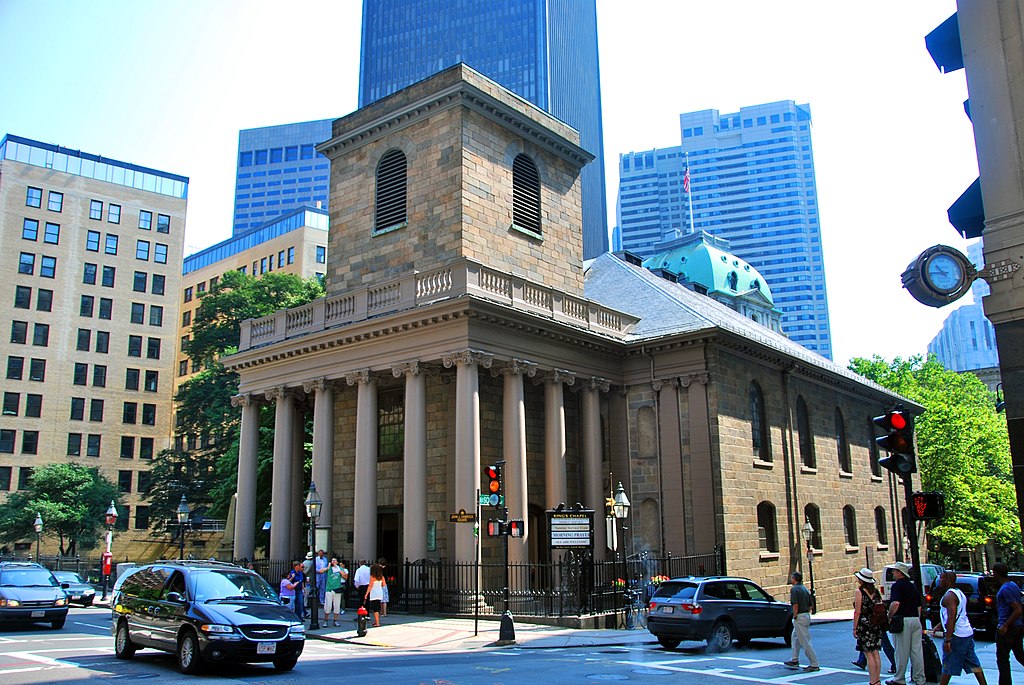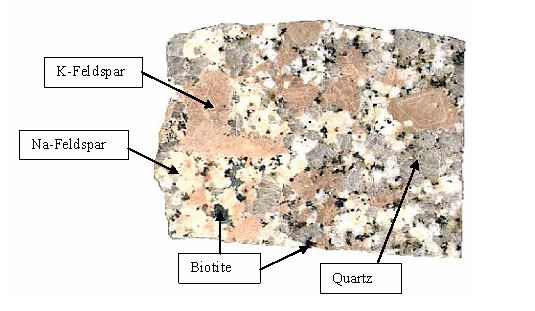
This cache is part of the Historic Boston GeoTour, a series of twelve caches that will take you through the city’s 400 years of history. One of the twelve is a bonus cache which will require you to also complete the Freedom Trail Adventure Labs. Completing the GeoTour will earn you 57 smileys, a Historic Boston GeoTour geocoin, and a Historic Boston digital souvenir.
You can do this earthcache without entering the building. King's Chapel is built of granite from a nearby town of Quincy, MA. To get credit for the earthcache, please send the answers to the questions below to my online account.

The front gate is open Friday through Saturday, and Monday 10:00 - 4:00, or on Sunday 12:00 - 4:00. Otherwise you can access the side of the building on School Street, which is always accessible. Permission was granted for the EarthCache.
Logging requirements
1. Describe the texture AND color of the granite at this location.
2. Describe the weathering process of this rock. Is there any rusting or corrosion? If so, where do you see it and why is this occurring?
3. Because granite is an igneous rock, it has many different types of minerals inside of it. Using the diagram below in the text, what is the most abundant mineral you see in this piece of granite?
4. Post a picture of yourself (face not required) or a personal item at the granite chapel.
Granite is a coarse-grained light colored igneous rock composed mainly of feldspars and quartz which together make up 90% of the rock. Quartz ranges from 20-45% and feldspar up to 60% of the granite. It is the interlaced crystals of feldspar and quartz, two very hard minerals, that gives granite it strength and makes it such a good building material. Granite also has a varying amount of other minor minerals, such as the black mica biotite, and the black amphibole hornblende, both of which gives granite its classic salt and pepper appearance.
The color of granite can range from pink to cream, white and grey; and depends on the type of feldspar that predominates. The potassium-rich orthoclase feldspar, has a salmon pink color, while sodium-rich plagioclase feldspar, is white to gray.

Granite is classified as igneous, arising from magma many miles below the surface. Granite formation begins when two tectonic plates collide. One plate will be pushed under the other creating a subduction zone. Rocks in the down-going plate are super-heated under extreme pressure, up to 1,600 degrees C, melting into magma which then rises upwards because it is hot and less dense than the surrounding material. About 10% of the magma will be pushed to the surface, erupting as volcanoes where rapidly cooling lava creates a variety of fine-grained rocks from basalt to obsidian. However, 90% of the magma will remain deep below the surface cooling slowly over a long period of time forming irregular masses of granite, which can be extremely variable in size, ranging from less than a few square miles to larger masses (batholiths) that are often hundreds or thousands of square miles in area. Beneath every mountain range formed over a subduction zone lies a huge bed of granite. Over eons, uplift and erosion removes miles of bedrock to expose the granite domes.

Quincy Granite
story is, quite literally, "as old as the hills." Deep in the geologic past, as continents collided, mountains rose up and were folded; under intense pressure, igneous rock was crystallized into granite. The gray stone ledges that eventually emerged in Quincy after millennia of erosion contained some of the highest quality granite in the world, prized for its hardness and durability.
Recognizing the value of the granite rocks that littered the town, the English colonists used them for foundations, wharves, doorsteps, and stone walls. As early as 1721, nearby Braintree voted in town meeting to fine anyone who carried stones off the common land. It was a remarkable bit of legislation for New England, where rocks were generally considered the most predictable, and most expendable, annual crop.
The stone was rarely used in colonial buildings. Collecting the rocks and finishing the edges took too much time and money. In spite of the constant threat of fire and the passage of laws requiring brick and stone buildings, most colonial structures were made of wood. One exception was King's Chapel, constructed in 1754 of granite boulders dug up in Quincy, split and hammered, and transported to Boston. When the church was completed, "it was the wonder of the country round. People coming from a distance made it an object to see and admire this great structure."
The demand for Quincy granite began to wane in the twentieth century, as building styles changed and builders chose more affordable materials. As the town's economy shifted from quarrying to shipbuilding, it benefited from the innovative transportation technologies and skilled labor base that the granite industry had developed. After World War II, the use of cement as a cheap substitute for quarried stone doomed the remaining granite operations. The last quarry in Quincy closed in 1963. In 1985 the Commonwealth of Massachusetts purchased 22 acres of abandoned quarry including the original Granite Railway Quarry. Today, the site is a popular destination for rock climbing, hiking, and scenic viewing.
The Historic Boston GeoTour
